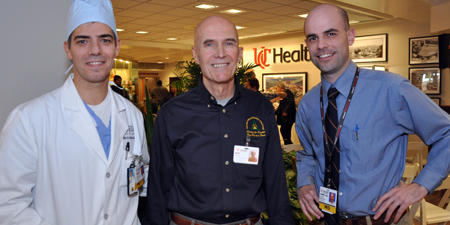
Bob Kehm, a clinical trial participant, with his doctors, Norberto Andaluz, MD, left, and Richard Curry, MD, right, of the UC Brain Tumor Center. Photo by Cindy Starr.
The day may soon arrive when all Ohio residents can gain access to a promising clinical trial within a short drive of their home. That is the hope behind the Ohio Clinical Trials Collaborative, which seeks to create a research medical corridor that makes new treatments accessible to all Ohioans.
The 2-year-project, a state-funded initiative supported by Governor John Kasich, includes the University of Cincinnati, Case Western Reserve University, The Ohio State University, and Wright State University, as well as the Cleveland Clinic, Cincinnati Children’s Hospital Medical Center and other hospitals in the state. Neuroscience and neuro-oncology (brain cancer) are two early focal points.
In a medical world churning with competing health systems, the Ohio Clinical Trials Collaborative arrives as a breath of fresh air: a scenario in which academic health centers are working together for the betterment of all patients.
“We are breaking down barriers of competition, something that is almost unheard of in healthcare,” says Ronald Warnick, MD, Medical Director of the UC Brain Tumor Center and the John M. Tew, Jr., MD, Chair in Neurosurgical Oncology. “Institutions that normally compete with one another have agreed to work together to overcome those competitive hurdles so that we can truly optimize our patients’ care and outcomes.”
“One of the Ohio Clinical Trials Collaborative’s short-term goals is to unite these centers in order to provide brain tumor trials for patients throughout the state of Ohio,” says Richard Curry, MD, a neuro-oncologist with the UC Brain Tumor Center.
“In the area of brain tumor research, there is strength in numbers,” Dr. Warnick says. “The greater the number of patients in a clinical trial, the more valuable and accurate our data will be. And the more sites that offer these clinical trials, the greater the opportunity for our patients, who can gain access to new therapies without leaving their geographical area.”
The State of Ohio is providing each participating center with a modest amount of funding for research assistance, nursing support and data collection, while corporations provide funding for the new treatments or therapies.
The collaborative was founded by the Center for Clinical and Translational Science and Training at UC and the translational research centers at Case Western and Ohio State University. Additional research collaborators from the UC Neuroscience Institute include otolaryngologists Ravi Samy, MD, and Myles Pensak, MD, who are affiliated with the UC Neurosensory Disorders Center and the UC Brain Tumor Center.
UC Neuroscience researchers who specialize in stroke and emergency medicine are also embraced by the collaborative through their membership in two national consortiums: the Neurological Emergencies Treatment Trials Network (NETT) and the Network for Excellence in Neuroscience Clinical Trials (Neuro NEXT).
As the Ohio Clinical Trials Collaborative gains traction, it is focusing on neuroscience, oncology, primary care, pediatrics and a streamlined internal review board (IRB) system that allows for the one-size-fits-all design and approval of clinical trials for multiple participating centers. The collaborative is also working to create a centralized Protocol Review and Monitoring Committee, which reviews the scientific merits of proposed cancer trials before they are presented to the IRB. The stringent IRB process is required by federal law for the protection of patients who decide to enroll in studies of new treatments.
“Our main purpose for the next two years is to see how successful this enterprise can be,” Dr. Curry says. “The oncology portion of the collaborative is at present limited to brain tumor clinical trials, including those in pediatric neuro-oncology. If we are successful in opening two to three new trials, the collaborative hopes to expand to include other cancers, such as breast and lung.”
The collaborative’s oncology goals include boosting Ohio’s high-tech job market, as money for new clinical trials must come from outside the state. This win-win objective – developing new treatments and driving job growth – is illustrated by the collaborative’s first oncology study, a Phase II Trial of NovoTTF-lOOA with Bevacizumab (Avastin) in patients with recurrent glioblastoma.
The study involves treating patients with 1) Avastin, a drug that inhibits the growth of new blood vessels; and 2) NovoTTF-lOOA tumor treating fields therapy, which involves the delivery of a low-intensity electric field with electrodes placed directly on the skin in the region surrounding the tumor. The electric field disrupts cell division and leads to subsequent cell death (apoptosis).
Investigators at the recent Society for Neuro-Oncology meeting in Miami released promising initial results from a large randomized Phase 3 trial, which used the Novo TTF-100A tumor treating fields therapy in addition to temozolomide (chemotherapy) in patients newly diagnosed with glioblastoma. The trial was halted early because of its success in increasing the survival of study participants.
Novocure, an international oncology company whose U.S. operations are based in Portsmouth, N.H., and New York, is sponsoring the new Avastin-NovoTTF-100A study, which is open at UC, Case Western and the Cleveland Clinic. The study expects to enroll about 40 patients.
In the meantime, patients across Ohio are likely to gain greater access to clinical trials that typically are not widely available. “Often times, if people want to get into a brain tumor clinical trial, the reality is that they will have to drive or fly to another center for that opportunity,” Dr. Curry says. “With this initiative, patients won’t have to travel long distances to get something that is state-of-the-art. This collaborative takes that enormous time commitment out of the equation.”
— Cindy Starr


